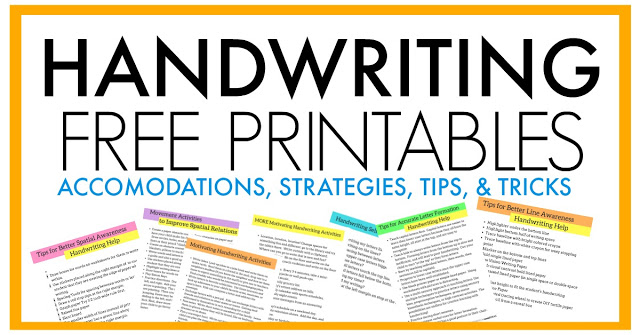Here, we’re talking all about reluctant writers. We’ll cover WHY kids hate to write, and we’ll discuss strategies to engage kids that are reluctant to write. You’ll also find TOYS and TOOLS to engage and motivate children that hate writing.
We’ve already covered fine motor toy ideas and pencil grasp toys, which can be a resource for reluctant writers. Today is all about play–based strategies to support reluctant writers. Our related blog post on name practice in kindergarten offers more strategies to support the child who is reluctant to write, particularly for beginners struggling with underlying skills needed for handwriting.
Amazon affiliate links are included in this blog post. As an Amazon Influencer, I earn from qualifying purchases.
Reluctant Writers
It’s very common for kids of all ages to be a reluctant to write. Challenges such as not knowing letter formation, struggles with dysgraphia, or difficulties with visual perceptual skills or visual motor skills that impact legibility can mean that kids just hate to write.
They hate to practice handwriting.
Motivating struggling writers to actually practice the underlying areas in which they struggle can be a challenge. For kids that HATE to write, meaningful and motivating is key! These writing activities for reluctant writes will make handwriting fun so that kids can work on the skills they need to work on.
Practice writing? “But Mom! I don’t like to write!” Sound familiar? Many kids (Many, many!) just aren’t into practicing their handwriting at home. School and homeschooling can be exhausting for kids when they have to do certain topics that they just aren’t interested in. And handwriting is often one of those topics.
Hopefully, you’ll find some motivating handwriting activities in today’s post that will help your reluctant writer pick up that pencil and start writing!

Handwriting Ideas for Reluctant Writers
Many kids just aren’t into practicing their handwriting at home. School and homeschooling can be exhausting for kids when they have to do certain topics that they just aren’t interested in. And handwriting is often one of those topics.
Often times, kids balk at having to do repetitive writing. I mean, would you want to write a word or sentence 10 times in a row? Sometimes a functional activity that is meaningful and helpful can motivate a child to want to pick up a pencil. In the end, emphasize handwriting quality over quantity and functional handwriting over perfection.
Here are a few easy hands-on strategies to help with “non-handwriting” ways to work on handwriting:
Try some of the handwriting through play ideas in our handwriting library.
Motivating Handwriting Activities Quick Tip:
Try using “handwriting toys” to sneak in the handwriting practice in fun ways that seem more like play than writing practice.
- Here are my favorite toys and tools to work on spacing.
- Use toys to work on pencil grasp.
- Or play games to work on pencil grasp.
- Try a fun activity like our ice cream writing activity! Kids love it.
Fine Motor Quick Tip:
Using a neutral or extended wrist is so important for pencil grasp, endurance in handwriting, and small motor movements of the fingers in isolation of the wrist. If your student is using a flexed (or bent) wrist, try paper position and placement. Encourage fine motor activities performed on a vertical surface or slanted surface.
.
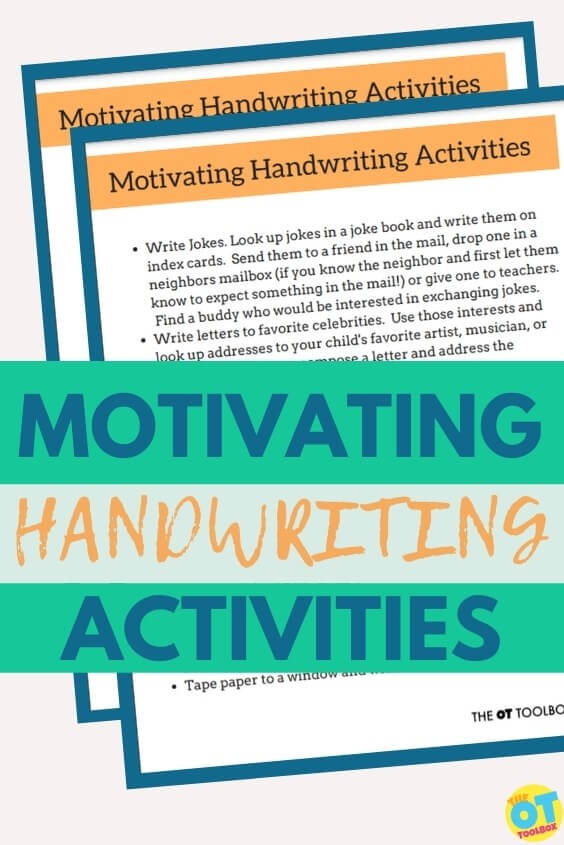
How to engage reluctant writers
{{This post contains affiliate links.}}
You can throw in the fun colored ink pen for extra smiles from your reluctant writer, but we wanted to share ideas to work on functional skills like handwriting using mainly items you can find around the home.
Try a few of these fun ideas with your student or child:
- Write Jokes. Look up jokes in a joke book and write them on index cards. Send them to a friend in the mail, drop one in a neighbors mailbox (if you know the neighbor and first let them know to expect something in the mail!) or give one to teachers. Find a buddy who would be interested in exchanging jokes.
- Write letters to favorite celebrities. Use those interests and look up addresses to your child’s favorite artist, musician, or sports hero. Kids can compose a letter and address the envelope.
- Exchange letters with a pen pal. Kids can exchange letters with friends and relatives in other states or towns. Getting mail addressed to themselves is very rewarding for a child.
- Pass notes. Write short notes to members of the family. Leave them in places where they will be found, like on bedroom dressers or in shoes. Notes might be simple things like, “Don’t forget about soccer practice today.” or fun things like, “Do you want to play checkers?”
- Plan a scavenger hunt. Write out hints on slips of paper. The child can plan the steps and hide notes for family members or friends.
- Practice letter formation during fun games like Tic Tac Toe. Instead of x’s and o’s, write printed or cursive letters in the squares.
- Write your own comic books. Draw large rectangles on a page for a comic story. Students can draw pictures and write comic bubbles for handwriting practice.
- Make a creative journal full of creative handwriting ideas. We did ours with a cursive handwriting, but you could use these ideas for printed handwriting, too.
- Tape paper to a window and write on the paper.
- Location, location, location! Change spaces for something fun and different: go to the library and try the tables there. Write outside with a clipboard. Where can you go to write that is new and fun?
- Change positions. Sit on the floor and write on the chair seat. Lay on couch cushions and write on the floor on a clipboard.
- Take brain breaks. Every 3-4 minutes, take a mini-break for jumping jacks or wall push-ups.
- Write to classical music.
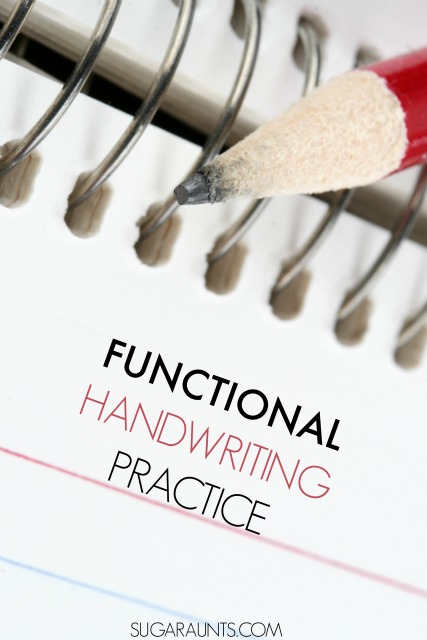
Functional Handwriting for reluctant writers
Often times, kids balk at having to do repetitive writing. I mean, would you want to write a word or sentence 10 times in a row? Sometimes a functional activity that is meaningful and helpful can motivate a child to want to pick up a pencil, especially when they are hesitant to try a writing task. Try some of these functional handwriting tasks:
- Write out the family grocery list.
- Write your family’s return address on bills.
- Write out a family calendar with sports schedules, outings, and family night events.
- Write out the phone messages from an answering machine.
- Write out the day’s schedule on a weekend day.
- Write out favorite television shows. Add the day, and time of each show.
- Write out a holiday or birthday gift wish list.
- Write out a list of items to pack for vacation. Include little squares next to each item to check off as items are packed.
- Practice forming letters and words in shaving cream.
- Sensory writing without a pencil.
- Write words on a foam tray.
Free Worksheet- Ideas for Reluctant Writers
Want to print off a list of handwriting ideas for reluctant writers to send home with your therapy caseload? Now you can add this list to your therapy toolbox! Join us in the free, 5 day email series where you’ll get this free 2 page list of writing ideas for reluctant writers. You’ll also access other handwriting handouts to cover areas of handwriting issues.
Click here to join the free 5 day Handwriting printables series.
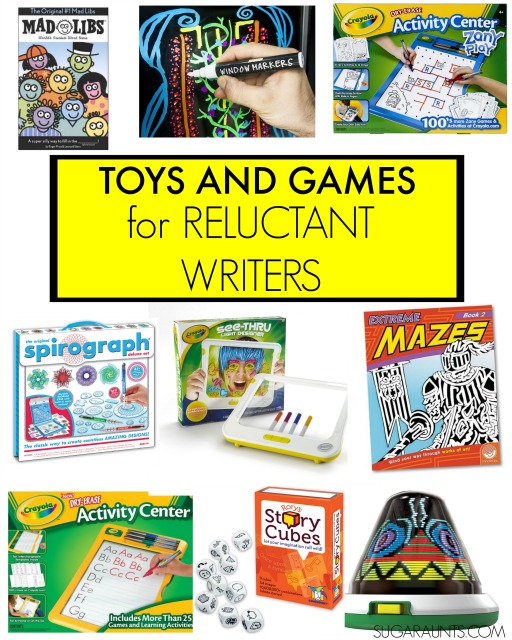
Toys for Reluctant Writers
Looking for more ways to help your reluctant writer get more “into” writing? These toys, tools, and games will inspire and encourage your child to want to pick up the writing tool and play.
The best thing is, they won’t even realize they are practicing handwriting and doing “work”! While these tools and toys are not free, they are ideas to try. If you have family asking for gift ideas, you might want to pass a few of these ideas along. Here’s to writing and loving it!
Amazon affiliate links included below.
- Kids love a dry erase board and this Crayola Dry Erase Activity Center (affiliate link) will be fun for them to practice letter formation and writing.
- The Crayola Dry-Erase Activity Center Zany Play (affiliate link) can be a fun way to practice individual letter formation. Ask your child to practice letters in each box. Kids can also work on starting/stopping the writing tool on the dots, which is great pencil control practice and needed for handwriting legibility.
- Writing on this Crayola See Thru Light Designer (affiliate link) is bright and colorful and a great way to really work on letters while your child is captivated by the light animations and color effects.
- For students who love to draw (or have a slight interest in drawing), this Crayola Light Designer (affiliate link) will be a huge hit. Even though they will not be writing letters and words, kids can draw with the writing tool to create 3D images of their drawings. This is a motivating tool for reluctant writers, and beneficial for pencil control and dexterity, helpful in handwriting.
- For kids who say “I can’t think of anything to write!” (sound familiar?) This creative storytelling game, Rory’s Story Cubes (affiliate link), will be a fun way to inspire. Play the game and write out stories as a family. This sounds like a great Family Night activity!
- Make writing fun with Washable Window Chalk Markers (affiliate link) by writing on windows, glass, and mirrors.
- Completing mazes are a great way to practice pencil control, line awareness in handwriting.
- Try a maze book like this Extreme Mazes (affiliate link) with your reluctant writer.
- Mad Libs Game (affiliate link) is a great way to practice handwriting on lines and in smaller spaces. For kids who can not write as small as needed to write in the book, use a piece of paper for filling in the answers.
- The handwriting practice that kids get with a Spirograph (affiliate link) is big: Pen control, bilateral hand coordination, and proprioceptive feedback. Creating these fun art pieces are motivating and fun!
Toys for Letter Formation
Helping kids to work on letter formation can help them to become more confident in their handwriting. Try these engaging toys to support written work:
Chuchik Magnetic Drawing Board-(affiliate link) Use the magnetic pen to “write” letters and then erase them, adding repetitions in letter formation.
Coogam Wooden Letters Practicing Board– (affiliate link) Use the wooden board to trace and form letters. Then place a paper over the board and use a crayon to form the letters using the textured letters.
Naturskool Sand Writing Tray for Letter Formation with Alphabet flashcards– (affiliate link) Work on letter formation and copying skills with a sensory tray and pencil-like writing stylus.
More Fun toys to practice pencil formation and handwriting. Below are Amazon affiliate links.
- Erasable Drawing Doodle Screen Board
- Osmo
- Crayola Colored Gel Pens
- My First Crayola Double Doodle Board
- Crayola Glitter Crayons
- Color Changing Magic Pens
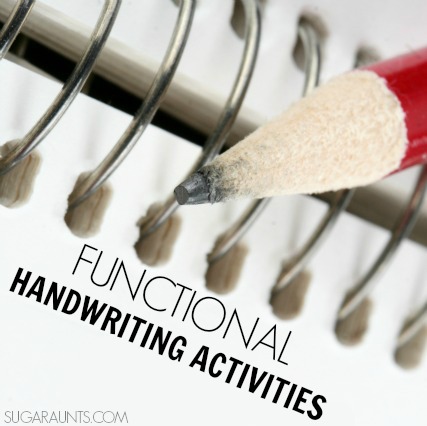
More Developmental Toys for Therapy
Be sure to check out these developmental toys, too. These are top-rated occupational therapy toys to support child development of skills.
- Fine Motor Toys
- Gross Motor Toys
- Pencil Grasp Toys
- Toys for Reluctant Writers
- Toys for Spatial Awareness
- Toys for Visual Tracking
- Toys for Sensory Play
- Bilateral Coordination Toys
- Games for Executive Functioning Skills
- Toys and Tools to Improve Visual Perception
- Toys to Help with Scissors Skills
- Toys for Attention and Focus
PRINTABLE LIST OF TOYS FOR Reluctant Writers
Want a printable copy of our therapist-recommended toys to support reluctant writers?
As therapy professionals, we LOVE to recommend therapy toys that build skills! This toy list is done for you so you don’t need to recreate the wheel.
Your therapy caseload will love these handwriting toy recommendations. (There’s space on this handout for you to write in your own toy suggestions, to meet the client’s individual needs, too!)

Colleen Beck, OTR/L has been an occupational therapist since 2000, working in school-based, hand therapy, outpatient peds, EI, and SNF. Colleen created The OT Toolbox to inspire therapists, teachers, and parents with easy and fun tools to help children thrive. Read her story about going from an OT making $3/hour (after paying for kids’ childcare) to a full-time OT resource creator for millions of readers. Want to collaborate? Send an email to contact@theottoolbox.com.


